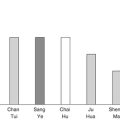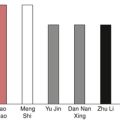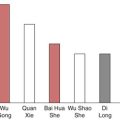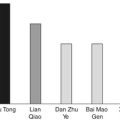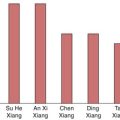Chapter Five. Herbs that expel Wind-Dampness
 |
1. What are the indications for herbs that expel Wind-Dampness?
Herbs that expel Wind-Dampness are used for treating Bi syndrome. ‘ Bi’ means ‘obstruction’. Bi syndrome is also translated as ‘Painful Obstruction syndrome’. This syndrome is caused by invasion of Wind, Dampness and Cold, which obstruct the meridians and cause pain in the muscles, tendons, bones and joints. Painful Obstruction syndrome can be divided into four types according to the exogenous pathogenic factors and the characteristics of the symptoms.
Wind Painful Obstruction syndrome
Wind Painful Obstruction syndrome is called ‘ Xing Bi’ in Chinese. ‘ Xing’ means ‘moving’ or ‘walking’. This syndrome is characterized by pain that migrates from joint to joint and from one place to another. The pain worsens during windy weather. Other symptoms and signs include tingling of the limbs, pain with a radiating nature, a normal tongue body with a white, thin coating and a moderate pulse. The pathogenic factors of Wind Painful Obstruction syndrome are Wind, Dampness and Cold, with Wind being the predominant factor. In clinical practice, it is often associated with diseases such as migraine, cervical or lumbar spondylosis, hyperosteogeny and rheumatic fever.
Cold Painful Obstruction syndrome
Cold Painful Obstruction syndrome is called ‘T ong Bi’. ‘T ong’ means ‘pain’ in Chinese. The syndrome is characterized by severe pain of a fixed, contracting or cramping nature. The pain worsens during winter or cold weather and is relieved by warmth. Other symptoms and signs include cold limbs and a preference for warmth, a purple or blue tongue body with a white, sticky or watery coating and a deep, wiry pulse. The pathogenic factors of this syndrome are Wind, Dampness and Cold, with Cold being the predominant factor. In clinical practice, it is often associated with diseases such as rheumatic fever, rheumatoid arthritis, osteoarthropathy and osteoporosis.
Damp Painful Obstruction syndrome
Damp Painful Obstruction syndrome is called ‘ Zhuo Bi’. ‘ Zhuo’ means ‘to wear’ and ‘to adhere’. The syndrome is characterized by a fixed, lingering pain and swelling of the joints or muscles associated with a heavy or numb sensation. The pain and swelling worsen during humid and cold weather. The other symptoms and signs are heaviness of the body, edema or difficult micturition, a light purple tongue body with a white, thick coating and a deep, moderate pulse. The pathogenic factors in this syndrome are Wind, Dampness and Cold, with Dampness being the predominant factor. In clinical practice, it can be seen in diseases such as chronic strain of the muscles or other soft tissues and various kinds of arthritis.
Hot Painful Obstruction syndrome
Hot Painful Obstruction syndrome is called ‘ Re Bi’. ‘ Re’ means ‘hotness’. It is characterized by painful and swollen joints with hot or burning sensations. The other symptoms and signs are fever, thirst, scanty urine, a red tongue body with a yellow coating and a rapid, slippery pulse. Hot Painful Obstruction syndrome is a development of the invasion of Wind, Dampness and Cold. First of all, when Wind, Dampness and Cold invade the body, they disturb the Qi movement and the Blood circulation. As the body puts up resistance in order to eliminate these pathogenic factors, Heat is produced in the process. Furthermore, Wind, Dampness and Cold can also turn into Heat if they are not eliminated in time and accumulate in certain meridians and joints. In clinical practice, this syndrome can be seen during the onset and active stage of rheumatic fever or rheumatoid arthritis, as well as frozen shoulder, tenovaginitis, bursal synovitis, pyogenic osteomyelitis and suppurative arthritis.
2. What are the characteristics of herbs that expel Wind-Dampness?
Herbs that expel Wind-Dampness are used for treating Bi syndrome. They are able to expel Wind, transform Dampness and warm the Interior. The characteristics of their properties and functions are as follows.
Pungent taste
Most of the herbs that expel Wind-Dampness are pungent. This gives the herbs the ability to expel Wind from the skin, muscles and bones. As Dampness is associated with Wind, when Wind is expelled by the pungent herbs then Dampness can be partially eliminated too. This function is called ‘wind disperses dampness’.
Pungent and warm
Many of the herbs are pungent and warm in nature, and are especially suitable for conditions where Cold or Wind-Cold predominates in the disease. Because the pungent taste can expel Wind and scatter Cold and the warmth can warm the Interior, warm-pungent herbs can alleviate pain quickly. Warm-pungent herbs are also suitable for usage in the winter, in cold climates and by elderly people. Herbs with a pungent and warm nature include Qiang Huo ( Notopterygii rhizoma), Du Huo ( Angelicae pubescentis radix), Wei Ling Xian ( Clematidis radix), Wu Jia Pi ( Acanthopanacis cortex) and Qian Nian Jian ( Homalomenae rhizoma).
Bitter, pungent and warm
Some of the herbs are bitter and pungent, and are especially suitable for treating Damp Painful Obstruction syndrome because bitterness and pungency can dry Dampness and reduce swelling and heavy sensations in the limbs. If the herb is also warm, the ability to expel Wind and Dampness is even stronger. Herbs with these properties are Song Jie ( Pini nodi lignum), Qian Nian Jian, Hai Feng Teng ( Piperis caulis), Hai Tong Pi ( Erythrinae cortex) and Cang Zhu ( Atractylodis rhizoma).
Salty or sour
Some substances are salty; they are especially suitable for disorders where Wind and Dampness are in the Interior of the body for a considerable time or when the bones are involved. The commonly used salty substances are Wu Shao She ( Zaocys), Bai Hua She ( Agkistrodon acutus)* and Wei Ling Xian. Sourness nourishes the Body Fluids and Yin and can therefore moderate cramps and relieve the pain of the tendons and muscles. Mu Gua ( Chaenomelis fructus) is often used for this purpose.
Entering the Kidney, Bladder and Liver meridians
In Bi syndromes, especially in chronic cases, the bones and tendons are impaired. Herbs that enter the Kidney and Liver meridians are often chosen because the Kidney and Liver govern the bones and tendons. Commonly used substances are Hai Feng Teng, Luo Shi Teng ( Trachelospermi caulis), Qian Nian Jian, Bai Hua She and Wu Shao She. Herbs that enter the Bladder meridian are often used to activate the Qi and Yang and to expel exogenous pathogenic factors from the skin, subcutaneous region and muscles. This is because the Bladder meridian covers the back of the body, which is considered as the Yang side of the body and is the first to be attacked by pathogenic Wind and Cold. Herbs with such functions include Qiang Huo and Wei Ling Xian.
More forms of administration
Substances that expel Wind-Dampness are not only used orally, but are also applied topically because local use may directly expel the exogenous pathogenic factors, activate the Qi and Blood circulation and ultimately break up the obstruction. The commonly used forms are herbal plasters, lotions and tinctures. In addition, herbal alcohol drink is also frequently used as part of the diet for patients who suffer from chronic Bi syndrome.
3. What are the commonly used methods and herbs for treating Bi syndrome?
Substances that expel Wind-Dampness are mainly pungent, warm and bitter, and enter the Liver, Spleen and Kidney meridians. Pungency has dispersing and moving properties, is able to disperse Wind-Dampness and Cold, and to activate the Qi movement and Blood circulation; bitterness can dry dampness; warmth can scatter Cold, warm the muscles and subcutaneous region and strengthen the function of the Defensive Qi. These substances are able to expel Wind, eliminate Dampness, scatter Cold, invigorate the collaterals, relax the tendons and alleviate pain. Some of the substances also have the function of tonifying the Kidney and Liver and strengthening the bones and tendons.
Substances that expel Wind-Dampness are mainly used for Bi syndromes. Since one or two exogenous pathogenic factors can be predominant in each condition, the symptoms can vary. It is very important to choose the proper herbs according to which of the four types of the Bi syndrome is present, the affected region, the duration of the disease and the constitution of the patient. The commonly used methods and herbs are as follows.
Expelling Wind
This method is mainly used for Wind Painful Obstruction syndrome, which is characterized by migrating pain. Pungent and warm herbs are often used, such as Fang Feng ( Saposhnikoviae radix), Qiang Huo ( Notopterygii rhizoma), Wei Ling Xian ( Clematidis radix), Hu Zhang ( Polygoni cuspidati rhizoma) and Wu Shao She ( Zaocys).
Eliminating Dampness
This method is mainly used for Damp Painful Obstruction syndrome, which is characterized by heaviness and numbness of the limbs. The herbs that are used in this condition are Han Fang Ji ( Stephaniae tetrandrae radix), Mu Gua ( Chaenomelis fructus), Bi Xie ( Dioscoreae hypoglaucae rhizoma), Qin Jiao ( Gentianae macrophyllae radix), Cang Zhu ( Atractylodis rhizoma) and Hai Tong Pi ( Erythrinae cortex).
Scattering Cold and warming the Interior
This method is mainly used for Cold Painful Obstruction syndrome, which is characterized by severe, fixed, cramping pain which worsens in cold weather or in winter. Herbs that can be used in this condition are Fu Zi ( Aconiti radix lateralis preparata)*, Chuan Wu ( Aconiti carmichaeli radix)*, Cao Wu ( Aconiti kusnezoffii radix)*, Gui Zhi ( Cinnamomi cassiae ramulus) and Xi Xin ( Asari herba)*.
Clearing Heat and eliminating Wind-Dampness
This method is mainly used for Hot Painful Obstruction syndrome, which is characterized by swelling and red joints with warm or burning sensations. Herbs that can be used are Sang Zhi ( Mori ramulus), Luo Shi Teng ( Trachelospermi caulis), Xi Xian Cao ( Sigesbeckiae herba), Huang Bai ( Phellodendri cortex) and Yi Yi Ren ( Coicis semen).
Invigorating the Blood and promoting circulation
This method is mainly used for chronic Bi syndromes or Bi syndromes characterized by stubborn pain. Commonly used herbs are Dang Gui ( Angelicae sinensis radix), Chuan Xiong ( Chuanxiong rhizoma), Hong Hua ( Carthami flos) and Chuan Niu Xi ( Cyathulae radix).
Dispersing the Lung-Qi, regulating the Qi from the Bladder meridian and expelling exogenous pathogenic factors
This method is mainly used during the onset of Bi syndrome when the exogenous pathogenic factors are in the superficial layer of the body, especially the upper body. The symptoms are sudden onset of pain, swelling of joints, fever, chills and general pain. Commonly used herbs are Qiang Huo, Fang Feng, Gao Ben ( Ligustici sinensis radix), Ma Huang ( Ephedrae herba)* and Xing Ren ( Armeniacae semen).
Invigorating the tendons, opening the collaterals and nourishing the Blood
This method is mainly used for chronic Bi syndrome, where Wind, Dampness and Cold stay in the muscles and tendons for a long period of time, obstructing the Qi and Blood circulation in the collaterals. Patients complain of stiffness of the body, tingling sensations and numbness of the limbs. Herbs that can be used in this condition are Shen Jin Cao ( Lycopodii herba), Hai Feng Teng ( Piperis caulis), Sang Zhi, Di Long ( Pheretima), Dang Gui Wei ( Angelicae sinensis radix extremitas) and Bai Hua She ( Agkistrodon acutus)*.
Tonifying the Liver and Kidney, strengthening the tendons and bones
This method is mainly used for chronic Bi syndrome in elderly people and patients with a weak constitution. Patients complain of weakness and stiffness of the joints, especially in the waist and knees, and difficulty with walking. Herbs which can be used for these complaints are Sang Ji Sheng ( Taxilli herba), Qian Nian Jian ( Homalomenae rhizoma), Gou Ji ( Cibotii rhizoma)**, Xu Duan ( Dipsaci radix), Gu Sui Bu ( Drynariae rhizoma), Xian Mao ( Curculinginis rhizoma), Xian Ling Pi ( Epimedii herba) and Wu Jia Pi ( Acanthopanacis cortex).
In clinical practice, these methods are often used together. For instance, to treat Wind Painful Obstruction syndrome, methods that expel Wind, invigorate the Blood and nourish the Blood are often used together. To treat Damp Painful Obstruction syndrome, methods that expel Wind, eliminate Dampness, disperse the Lung-Qi and invigorate the sinews are often used together. To treat Cold Painful Obstruction syndrome, methods that scatter Cold, warm the Interior and promote Blood circulation are often used together. To treat chronic Bi syndrome, tonifying methods are often used together with methods for eliminating exogenous pathogenic factors.
4. What are the differences between Qiang Huo ( Notopterygii rhizoma) and Du Huo ( Angelicae pubescentis radix)?
Qiang Huo and Du Huo are commonly used herbs to expel Wind, Dampness and Cold from the body and to treat Bi syndrome. In clinical practice, they are often used together to treat rheumatic fever, rheumatoid arthritis and other disorders of the muscles, tendons, nerves and joints which are characterized by pain, heaviness, stiffness, tingling sensations and numbness of the affected area. Qiang Huo and Du Huo were considered to be one in ancient times and were used with little difference in their functions. Later, however, they were recognized to be two different herbs with slight differences in their functions.
Qiang Huo has a pungent, bitter taste and is warm in nature. It enters the Bladder meridian primarily, and the Liver and Kidney meridians secondly. The pungent and warm nature gives Qiang Huo strong dispersing and ascending ability; it is very effective for expelling Wind, Dampness and Cold quickly in the superficial layers of the body such as the skin, subcutaneous region and muscles, especially of the upper body. It is suitable for treating general pain, headache, stiffness of the back (such as in cold and influenza infections), in acute stages of arthritis and in other disorders of the muscles and joints.
Du Huo is also pungent, bitter and warm, but much gentler in nature than Qiang Huo. It enters the Kidney meridian and is especially effective in eliminating Wind, Dampness and Cold from the deeper layers of the body, particularly of the lower body. Because of its nature, Du Huo eliminates pathogenic factors from the body in a more constant and gentler way. It is more suitable for treating chronic cases of arthritis and other disorders of the muscles and joints when the patient complains the pain is in the bones and deep in the joints. Because it enters the Kidney meridian and treats Bi syndrome, Du Huo is more effective for disorders of the knees, back and heels.
Comparing these two herbs in the treatment of Bi syndromes, Qiang Huo is the warmer and has better results in eliminating Cold and relieving pain; Du Huo is more effective for eliminating Damp and has better results in treating heaviness and numbness of the body and joints. In clinical practice, Qiang Huo and Du Huo are often used together because Bi syndromes have chronic, recurrent processes, mostly affecting the whole body, in which pain and heaviness often coexist. Although there are differences between the natures of these two herbs, both are pungent and warm. In patients who suffer from chronic Bi syndrome as well as deficiency of the Yin and Body Fluids, these two herbs, and especially Qiang Huo, should be used with caution. It is wise to add herbs which tonify the Yin and Blood and promote the Blood circulation during the treatment.
5. What are the differences between the two kinds of Wu Jia Pi?
The two kinds of Wu Jia Pi are Nan Wu Jia Pi ( Acanthopanacis cortex), which means ‘Wu Jia Pi from the south’, and Bei Wu Jia Pi ( Periploca sepium bunge), which means ‘Wu Jia Pi from the north’. Both are commonly used herbs for treating Bi syndrome. They are pungent, bitter and warm, enter the Liver and Kidney meridians and are able to expel Wind and Dampness, tonify the Liver and Kidney and strengthen the tendons and bones. They are especially suitable for treating Wind and Damp Painful Obstruction syndrome with weakness of the Liver and Kidney. They also have the function of promoting urination, reducing edema and treating swelling of the joints. Comparing these two herbs, Nan Wu Jia Pi is better for expelling Wind-Dampness and strengthening the bones; Bei Wu Jia Pi is more effective for promoting urination and reducing edema.
6. What are the characteristics of Mu Gua ( Chaenomelis fructus)? What are the differences between Mu Gua and Bai Shao Yao ( Paeoniae radix lactiflora) for relaxing the tendons?
Mu Gua is sour, warm and aromatic. It primarily enters the Spleen meridian. It can transform Dampness in the Middle Jiao, revive the Spleen and harmonize the Stomach. It can be used for Exterior Damp-Cold in the Middle Jiao, and treat vomiting and diarrhea, cramping pain in the abdomen and even cramp in the legs. It also enters the Liver meridian and transforms Dampness and relaxes the muscles and tendons. It can be used for Damp Painful Obstruction syndrome in which stiffness of the body, cramp in the limbs, swelling of the ankles and difficulty with walking are present. It is an aromatic herb, but its tendency of action is descending; it is commonly used for Dampness in the lower body.
Mu Gua and Bai Shao Yao are both able to relieve cramping pain in the abdomen, cramp of the muscles and tendons of the limbs, and they can be used together. However, there are some differences between their actions.
Mu Gua relaxes the tendons by transforming Dampness and invigorating the collaterals; it treats cramps and stiffness which are caused by dampness. Bai Shao Yao is sour and cold and enters the Liver meridian. As sourness and cold generate Yin, it is able to nourish the Yin and Blood of the tendons, therefore relaxing the muscles, tendons and ultimately alleviating cramp. It treats cramp which is caused by Yin deficiency. If cramp is caused by obstruction of Dampness as well as Yin deficiency, Mu Gua and Bai Shao Yao should be used together.
7. What are the characteristics of Xi Xin ( Asari herba)*, Wei Ling Xian ( Clematidis radix), Hai Tong Pi ( Erythrinae cortex), Xi Xian Cao ( Sigesbeckiae herba) and Lu Lu Tong ( Liquidambaris fructus)?
These five herbs have a strong moving ability and are commonly used to treat Painful Obstruction syndrome, but there are some differences between their functions.
Xi Xin is very pungent and warm and enters the Lung, Heart and Kidney meridians. As well as its function of expelling Wind and Cold and releasing the Exterior, its pungent and aromatic smell give it a penetrating ability, allowing it to enter the deeper layers of the body. No matter how deep the pathogenic factors penetrate and how tight the tissues may be, Xi Xin is very effective for eliminating the Wind and Cold, opening up the meridians and collaterals and alleviating pain. In clinical practice, it is often used for Cold Painful Obstruction syndrome, especially chronic cases. It is also used in elderly people and in winter when the pain is severe and deep in the bones, accompanied by other cold signs such as cold limbs and a preference for warmth, a purple or blue tongue body with a white coating and a deep, slow and wiry pulse.
Wei Ling Xian is pungent, salty and warm and enters the Bladder meridian. It has dispersing, moving and opening abilities, moves very quickly and has a fairly strong action in expelling Wind and transforming Dampness, compared with other herbs with similar functions. Compared with Xi Xin, although it is not able to penetrate to the same depth and is less effective in stopping pain, it is very effective for opening up the meridians and collaterals, and treating numbness, paralysis and tingling sensations in the limbs. Because it moves quickly, the therapeutic effect is rapid. Moreover, Wei Ling Xian powder can also be used with alcohol, which strengthens its moving ability.
Hai Tong Pi is bitter, pungent and neutral and enters the Liver and Kidney meridians. It has similar functions to Wei Ling Xian, expelling Wind-Dampness and treating numbness of the limbs. But the speed of Hai Tong Pi is not as great as that of Wei Ling Xian and it is not so strongly and sharply pungent, so its dispersing ability does not spread over as large an area as Wei Ling Xian. It characteristically opens up the meridians and collaterals, directly reaching the affected region. In clinical practice, it is used more for stiffness and numbness of the waist and knees. As it is a neutral herb, it can be used for Bi syndrome with either Cold or Heat symptoms in the pathological changes.
Xi Xian Cao is pungent, bitter and cold and enters the Liver and Kidney meridians. Like Xi Xin, its pungent taste gives it a dispersing ability to enter the deep layers of the body, the tendons and the bones, to search and expel Wind; however, unlike Xi Xin, instead of expelling Cold, it expels Dampness and Heat. In clinical practice, it can be used when the Bi syndrome is in the active stage and the joints are swollen and painful with burning sensations. Like Wei Ling Xian and Hai Tong Pi, it can eliminate Wind-Dampness and treat heaviness and numbness of the limbs. Because it enters the Liver and Kidney meridians, it is especially effective in treating weakness and stiffness of the knees and back, pain in the bones, numbness and tingling sensations in the limbs—for instance, in hemiplegia and paralysis.
Lu Lu Tong is pungent, bitter and neutral and enters all the meridians. ‘ Lu’ in Chinese means ‘road’; ‘T ong’ means ‘open’—hence the name means ‘all roads open’. Lu Lu Tong is able to open the meridians and collaterals, expel Wind-Dampness and treat stiffness and numbness of the limbs in Bi syndrome. It can also treat urinary retention, edema and eczema, and can promote lactation of milk after giving birth because it can open up all the meridians and collaterals to promote the movement of water and Qi.
8. What are the characteristics of Fu Zi ( Aconiti radix lateralis preparata)*, Chuan Wu ( Aconiti carmichaeli radix)*, Cao Wu ( Aconiti kusnezoffii radix)*, Xi Xin ( Asari herba)* and Gui Zhi ( Cinnamomi cassiae ramulus) for treating Bi syndrome? What are the precautions for using these herbs?
These five herbs are all pungent and hot, are able to scatter internal Cold, dry Dampness, excite the Yang and Qi, and open up the meridians and collaterals. They are also very effective for alleviating pain. In clinical practice, they are often used to treat Bi syndromes which are mainly caused by Cold. In this situation, patients complain of severe pain in the joints, muscles and bones. However, these herbs have different strengths and characteristics, so are used in different conditions.
Fu Zi is very pungent and hot and enters the Heart, Spleen and Kidney meridians. It is swift and violent in its action of spreading warmth, scattering Cold, drying Dampness and warming the meridians. It is often described as the sun; when the sun is rising, the fog disappears immediately. Because of its strength, it is considered to be a herb that enters the 12 meridians. It is used to treat Bi syndromes especially when Cold is predominant with symptoms of cramping, severe pain and stiffness in the muscles, tendons and bones which worsen in cold weather.
Chuan Wu and Cao Wu are similar but stronger in their action compared with Fu Zi. They are also considered stronger for expelling Wind, opening up the meridians and are suitable for treating Bi syndrome where Wind and Cold are predominant, and the main symptoms are numbness of the skin, general pain, severe pain in the joints and bones, stiffness of limbs and cramping in the abdomen.
Xi Xin is pungent and hot and enters the Heart, Lung and Kidney meridians. It is characterized by searching for and expelling Wind and Cold from the deep levels of the body. Xi Xin has good results for alleviating pain in the bones and joints. Apart from treating Bi syndromes, it can also be used for headache, migraine, trigeminal neuralgia, toothache and pain caused by sinusitis.
Gui Zhi is pungent, sweet and warm and enters the Heart, Lung and Bladder meridians. Unlike Fu Zi, which spreads warmth quickly, and unlike Xi Xin, which expels Cold from deep regions, it expels Wind and alleviates pain by warming the meridians, activating and tonifying the Heart-Yang, promoting the Blood circulation and relaxing the tendons. It has a sweet taste, which makes this herb move more slowly than the others; however, as it can tonify the Heart and its action lasts longer, the patient’s condition can be improved more steadily. Besides treating Bi syndrome, it can also be used in Raynaud’s disease, vasculitis, pulmonary heart disease, rheumatic heart disease, coronary heart disease and dysmenorrhea.
Except for Gui Zhi, the herbs are very poisonous, and especially Cao Wu. They must be used only after processing, and even then the dosage must be controlled carefully. Large dosage or long-term usage may consume the Yin and further injure the Yang, especially when the Yang of the internal organs is weak. Except for Gui Zhi, the herbs are pungent and hot. Moving quickly without staying tendency, they can activate the functions of the internal organs in a short time but the condition of the patient is not improved steadily. Therefore it is advisable to use them combined with sweet and warm herbs, which can tonify the Yang and Qi. Moreover, Chuan Wu and Cao Wu are incompatible with Chuan Bei Mu ( Fritillariae cirrhosae bulbus), Zhe Bei Mu ( Fritillariae thunbergii bulbus), Gua Lou ( Trichosanthis fructus), Ban Xia ( Pinelliae rhizoma), Bai Lian ( Ampelopsitis radix) and Bai Ji ( Bletillae tuber)**.
9. What are the differences in the function of tonifying the Liver and Kidney, strengthening the tendons and bones between Xu Duan ( Dipsaci radix), Gu Sui Bu ( Drynariae rhizoma), Sang Ji Sheng ( Taxilli herba) and Gou Ji ( Cibotii rhizoma)**
All of these four herbs are bitter and warm, and enter the Liver and Kidney meridians. They have the function of expelling Wind-Dampness, tonifying the Liver and Kidney and strengthening the tendons and bones. They can treat chronic Bi syndrome which is characterized by stiff joints, sore and painful back and knees, weakness of the legs and difficulty with walking, but there are some differences between their functions.
In Chinese, ‘ Xu’ means ‘successive’, ‘join’ or ‘add’; ‘D uan’ means ‘break’. Therefore the name Xu Duan suggests its function: it can invigorate the Blood, promote healing of the bones and tendons and it is especially suitable for treating trauma and fracture. Xu Duan also has the ability to strengthen the Directing ( Ren) meridian and treat habitual miscarriage.
In Gu Sui Bu, ‘ Gu’ means ‘bone’, ‘S ui’ means ‘break’ and ‘ Bu’ means ‘supplement’. Like Xu Duan, Gu Sui Bu can promote Blood circulation, alleviate pain, and promote healing of the bones and tendons. It is warmer than Xu Duan and enters the Lower Jiao. It warms the Fire of the Gate of Vitality ( Ming Men) and therefore can also be used for elderly people and patients who suffer from cold sensations in the back and feet, diarrhea, frequent urination, deafness, tinnitus and toothache.
Comparing Xu Duan with Gu Sui Bu, Xu Duan primarily enters the Liver meridian. It promotes healing of the tendons and strengthens them. Gu Sui Bu primarily enters the Kidney meridian and promotes healing of the bones and strengthens them.
Sang Ji Sheng is a gentle herb, neutral and moist; it can nourish the Blood, relax the tendons and is especially suitable for chronic Bi syndrome. It can also calm the fetus and is often used with Xu Duan to treat uterine bleeding in pregnancy and also for prevention of miscarriage.
In Gou Ji, ‘ Gou’ means ‘dog’ and ‘ Ji’ means ‘spine’, because the shape of this herb is like the spine of a dog. Gou Ji not only enters the Liver and Kidney meridians, but also enters the Governing ( Du) meridian. It is especially effective for strengthening the bones, breaking up obstructions and treating stiffness, weakness and pain in the back or throughout the spinal column.
Because in chronic Bi syndrome both the Liver and Kidney are weak, and the bones, tendons and muscles are all involved in the pathological process, these herbs can be used together to strengthen the therapeutic effects.
10. What are the differences between Bai Hua She ( Agkistrodon acutus)* and Wu Shao She ( Zaocys)?
Bai Hua She and Wu Shao She are two species of snakes. Both enter the Liver meridian. It is believed that they can reach any part of the body, no matter how deep, because the snake has drilling and moving abilities. They have the ability to expel exogenous Wind from different areas of the body, no matter how deep and for how long the Wind remains. In clinical practice, they are important substances for treating chronic Wind Painful Obstruction syndrome, which is seen in hemiplegia after cerebrovascular accident, facial paralysis and other disorders, which are characterized by stiffness and cramping of the tendons, numbness of the muscles and tingling sensations of the limbs. They can also extinguish internal Wind, control spasms and convulsions, and are also used for epilepsy, convulsions in children and tetanus.
Bai Hua She is sweet, salty, warm and poisonous. Its action in expelling external Wind and extinguishing internal Wind is very strong and quick. Wu Shao She is sweet and neutral; its action is gentler and slower than that of Bai Hua She. In clinical practice, they are often used together to accentuate their effects. They are also often used together with Wu Gong ( Scolopendra)* and Quan Xie ( Scorpio)* to relieve spasm, and with Di Long ( Pheretima) to open up the meridians and collaterals.
11. What are the characteristics of Hai Feng Teng ( Piperis caulis), Qing Feng Teng ( Sinomenii caulis), Luo Shi Teng ( Trachelospermi caulis) and Sang Zhi ( Mori ramulus)?
These four herbs are commonly used for expelling Wind-Dampness and unblocking the meridians. When symptoms of stiffness and pain in the joints and muscles are present, they can all be used. In TCM, similes and allegories are used to explain the complicated links between physiology and pathology, as well as the correlation between humans and the natural environment—for instance, the peel of the herb links with the skin; the core, the sprout, links with the Heart; the twig of the plant enters the limbs and meridians; the vine enters the meridians and collaterals. The first three herbs are considered to be the vines and Sang Zhi is the branch. These herbs work particularly on the meridians and collaterals. When Wind-Dampness obstructs the meridians and collaterals and the Qi and Blood fail to nourish and support the meridians and collaterals, the joints and muscles in the affected place become painful, stiff, heavy and numb. These four herbs are particularly suitable for treating such disorders.
Hai Feng Teng is pungent, bitter and slightly warm and enters the Liver and Kidney meridians. Pungency can disperse Dampness and Cold; bitterness can dry Dampness; warmth can scatter Cold and open up the meridians. This herb is usually used for Bi syndromes caused by Wind, Dampness and Cold; here the symptoms are characterized by cramping pain and stiffness in the limbs.
Qing Feng Teng and Sang Zhi are bitter and neutral herbs, and enter the Liver meridian. Both are used for Bi syndrome caused by Wind-Dampness, either with or without Heat or Cold signs. They are able not only to eliminate Dampness, but also to promote urination, which is especially useful when Bi syndrome is accompanied by symptoms such as edema and scanty urine. In addition, these two herbs can be administered in other ways. Qing Feng Teng alcohol drink can be used to reduce numbness, tingling sensations or itchy sensations in the muscles; Sang Zhi can be used in moxibustion to warm the meridian in the locality and expel Wind-Dampness.
Luo Shi Teng is bitter and slightly cold and enters the Heart, Liver and Kidney meridians. Compared with the other herbs in this group, it is more suitable for treating Hot Painful Obstruction syndrome and is especially used for Bi syndrome caused by Heat, Dampness and Wind when the joints and muscles are warm, swollen, contracted and painful.
Also, of these four herbs, Hai Feng Teng and Luo Shi Teng can regulate the Blood circulation. Hai Feng Teng opens up the meridians and can be used with other herbs that promote Blood circulation and treat pains caused by trauma. Luo Shi Teng can also be used to treat trauma, but its action is to cool the Blood, reduce congealed Blood and thereby alleviate pain and swelling.
12. What are the characteristics of Shen Jin Cao ( Lycopodii herba) and Tou Gu Cao ( Tuberculate speranskia herba)?
In Chinese, ‘S hen’ means ‘stretching’, ‘ Jin’ means ‘tendons’ and ‘ Cao’ means ‘grass’. The name indicates the function of this herb. Although it is a pungent, bitter and warm herb, it is not dry in nature. It enters the Liver meridian and is especially effective for treating disorders of the tendons. It is able to expel Wind, open up the meridians, promote Blood circulation and relax the tendons. It is considered to be an important herb for the tendons. In clinical practice, it is mostly used for chronic Bi syndrome with contracted limbs, difficulty in movement, soreness of the tendons and bones and numbness of the skin. It is often used together with herbs that regulate the blood and tonify the Liver and Kidney.
In Chinese, ‘T ou’ means ‘penetrate’, ‘ Gu’ means ‘bone’ and ‘ Cao’ means ‘grass’. As described in the name, Tou Gu Cao is able to reach the bones, expel Wind and eliminate Dampness from the bones. It is a bitter and warm herb and enters the Liver and Kidney meridians. In clinical practice, Tou Gu Cao can be applied when Wind, Dampness and Cold remain in the body for a very long time, and the tendons become very stiff and the joints and the bones are very painful. It is often used together with herbs that tonify the Kidney and Liver and expel Wind, Cold and Dampness. Tou Gu Cao is also applied topically in lotions. If this herb is cooked with vinegar and the affected limb or joint is placed over the vapor for a considerable amount of time, it can treat spurs, such as spurs on the calcaneus.
13. What precautions should be observed when herbs that expel Wind, Cold and Dampness and treat Bi syndrome are used?
Wind, Cold and Dampness are common exogenous pathogenic factors and Bi syndrome is very commonly seen in clinical practice, so herbs that expel Wind, Cold and Dampness are frequently used. Because they are mostly warm, pungent and bitter, and have a drying nature, they should be used carefully when the patient has a condition of Yin, Blood or Body Fluid deficiency.
Some of these herbs have very good results in alleviating pain and relieving the suffering of the patient, but they are toxic herbs and overdose may lead to poisoning and even death. As toxicity is influenced by the growing habitat of the herbs, the method of processing and the patient’s sensitivity, it may vary greatly. Another feature is that the toxic dose is very close to the therapeutic dose, so the dosage and therapeutic duration should be controlled carefully. Some patients think that herbs are natural products and have no side-effects or toxic effects, but this is not completely true. The important thing is to use them properly. There are cases of fatalities; one patient died after taking seven pieces of Ma Qian Zi ( Strychni semen)* and another died because he doubled the dosage of the herbs himself due to severe pain. Thus it is worth mentioning the toxic herbs that are commonly used to alleviate pain and treat Bi syndrome. These are Fu Zi ( Aconiti radix lateralis preparata)*, Chuan Wu ( Aconiti carmichaeli radix)*, Cao Wu ( Aconiti kusnezoffii radix)*, Ma Qian Zi ( Strychni semen)*, Lei Gong Teng ( Tripterygii wilfordii caulis)*, Xi Xin ( Asari herba)*, Wei Ling Xian ( Clematidis radix) and Bai Hua She ( Agkistrodon acutus)*.
Comparisons of strength and temperature in herbs that expel Wind-Dampness
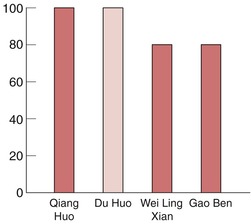 |
| Fig. 5.1. |
| Comparison of the herbs that expel Wind, Dampness and Cold. Qiang Huo ( Notopterygii rhizoma), Du Huo ( Angelicae pubescentis radix), Wei Ling Xian ( Clematidis radix), Gao Ben ( Ligustici sinensis radix). |
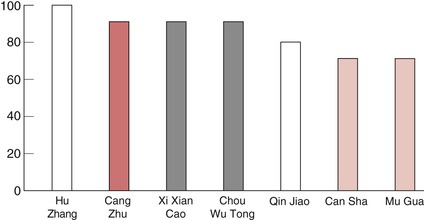 |
| Fig. 5.2. |
| Comparison of the herbs that expel Wind-Dampness. Hu Zhang ( Polygoni cuspidati rhizoma), Cang Zhu ( Atractylodis rhizoma), Xi Xian Cao ( Sigesbeckiae herba), Chou Wu Tong ( Clerodendri folium), Qin Jiao ( Gentianae macrophyllae radix), Can Sha ( Bombycis mori excrementum), Mu Gua ( Chaenomelis fructus). |
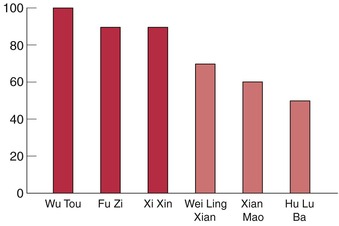 |
| Fig. 5.3. |
| Comparison of the herbs that expel Cold-Dampness. Wu Tou ( Aconiti radix)*, Fu Zi ( Aconiti radix lateralis preparata)*, Xi Xin ( Asari herba)*, Wei Ling Xian ( Clematidis radix), Xian Mao ( Curculinginis rhizoma), Hu Lu Ba ( Trigonellae semen). |
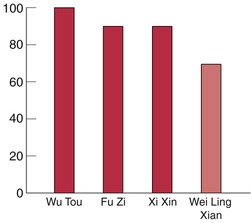 |
| Fig. 5.4. |
| Comparison of the herbs that expel Cold-Dampness and stop pain. Wu Tou ( Aconiti radix)*, Fu Zi ( Aconiti radix lateralis preparata)*, Xi Xin ( Asari herba)*, Wei Ling Xian ( Clematidis radix). |
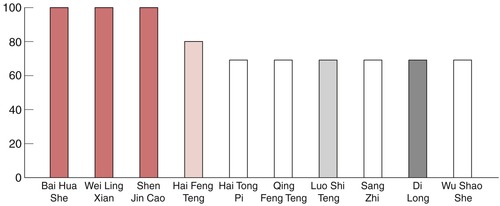 |
| Fig. 5.5. |
| Comparison of the herbs that expel Wind-Dampness and open the meridians. Bai Hua She ( Agkistrodon acutus)*, Wei Ling Xian ( Clematidis radix), Shen Jin Cao ( Lycopodii herba), Hai Feng Teng ( Piperis caulis), Hai Tong Pi ( Erythrinae cortex), Qing Feng Teng ( Sinomenii caulis), Luo Shi Teng ( Trachelospermi caulis), Sang Zhi ( Mori ramulus), Di Long ( Pheretima), Wu Shao She ( Zaocys). |
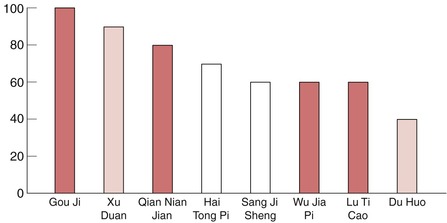 |
| Fig. 5.6. |
| Comparison of the herbs that tonify the Kidney and Liver and expel Wind-Dampness. Gou Ji ( Cibotii rhizoma)**, Xu Duan ( Dipsaci radix), Qian Nian Jian ( Homalomenae rhizoma), Hai Tong Pi ( Erythrinae cortex), Sang Ji Sheng ( Taxilli herba), Wu Jia Pi ( Acanthopanacis cortex), Lu Ti Cao ( Pyrola rotundifolia), Du Huo ( Angelicae pubescentis radix). |
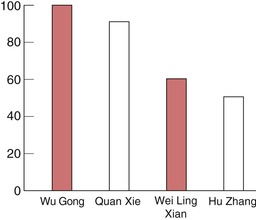 |
| Fig. 5.7. |
| Comparison of the herbs that expel Wind and relieve pain. Wu Gong ( Scolopendra)*, Quan Xie ( Scorpio)*, Wei Ling Xian ( Clematidis radix), Hu Zhang ( Polygoni cuspidati rhizoma). |

